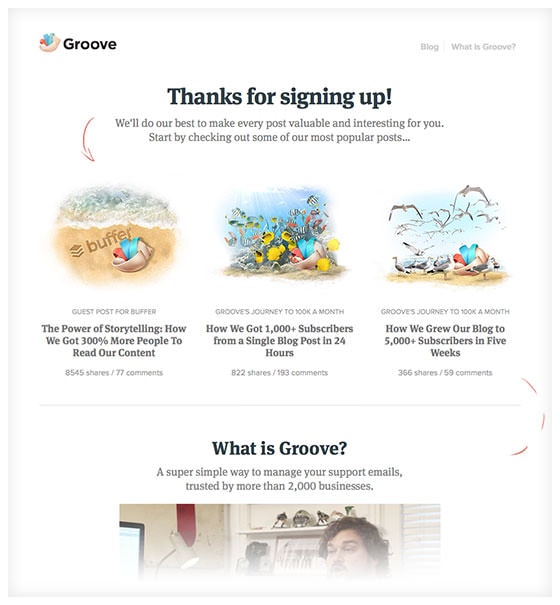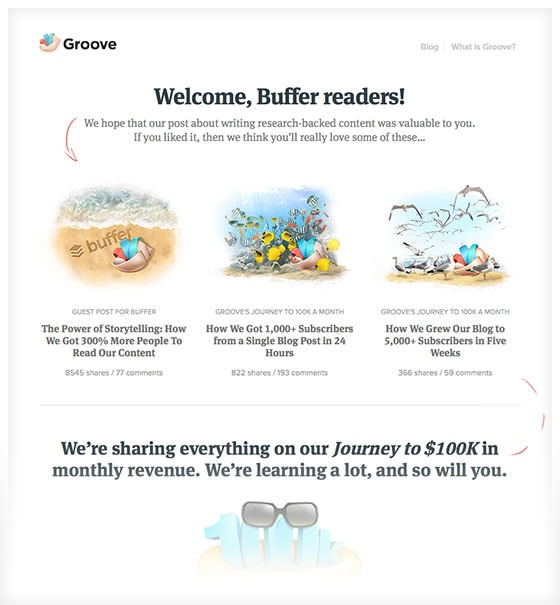
Your blog is a great way to deliver value to your prospects and establish yourself as an authority in your niche.
But if you’re not blogging strategically – with your business goals in mind – then chances are you’re preventing hoards of interested prospects from converting.
A successful content marketing plan shouldn’t only bring you visitors. If done right, it should also bring you thousands of new prospects and customers.
Our blog is – by a huge margin – our biggest source of new customers. We’ve done some stuff right, and a lot of stuff wrong (especially in the beginning). And we’ve learned a massive amount from both our wins and our fails.
Here are the four biggest, most costly mistakes we made early on. I hope that by sharing them, you can avoid the same fails and start reaping the benefits of a successful blogging strategy.
Mistake #1: Not directing blog readers to a landing page
Your blog posts aren’t sales pitches. And that’s a good thing, because your posts should be free, high-value resources that will help readers solve their problems before they buy.
But as a marketer, you still need to grow your business. And if you’re not leveraging your blog for growth, then it’s not an asset to your business.
Now, that doesn’t mean you have to write posts to pitch your readers. But there are many things you can do to optimize your blog for prospects who are ready to convert.
One of them is directing blog readers to a dedicated landing page.
How do I know this is effective? Because as soon as we started to directly offer our service to blog subscribers by directing them to a landing page, we started getting significantly more conversions.
In the past, when a reader signed up for our email list, they’d get an email welcoming them to the list, and that was it. No pitch. Now, when a reader signs up, they’re taken to a landing page built just for blog readers:
We’ve started to use the same approach for our guest blogging, too. Before, readers who clicked on links to Groove in our guest posts would be taken to our homepage.
Now, readers are sent to a targeted landing page, customized for each guest post.
For example, a recent guest post on the Buffer blog linked to a custom offer page for Buffer readers.
Of the traffic that reached that page, more than 15% of them signed up for an extended free trial of Groove.
Setting up one of these landing pages doesn’t take long and it can be a game changer for your business. If you’re ready to create one, here are a few things you should include:
- Make it highly targeted (for example, we welcome Buffer readers specifically in the headline) and thank the reader for enjoying the blog.
- Share similar content to what they just read to get them more engaged with the blog.
- Explain what your service is (and the problem it solves).
- Offer a special blog-readers-only-offer (we offered an extended trial that isn’t available on our main site).
Mistake #2: Spending too much time writing
Running a successful blog is a big undertaking; it takes a lot of keeping your head down to write, edit and format.
When we first started blogging, 95% of the time we spent on the blog was on writing. The other 5% was spent on some scattered tweets and emails to try and get the content in front of others.
Writing post after post, it was so frustrating not to see much traffic or many shares.
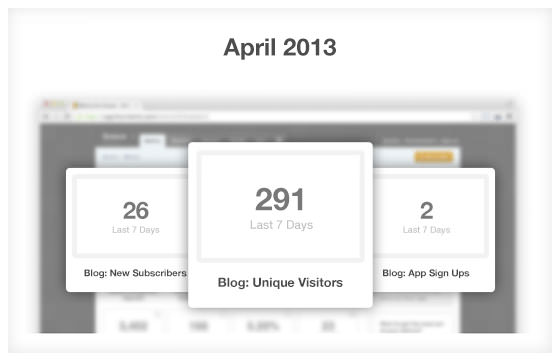
After launching our new blog, we did a ton of research on content marketing and studied how other companies leveraged blogs for traffic and conversions.
One of the most surprising lessons was just how much more to successful blogging there was than, well, blogging.
The most successful content marketers I talked to all said the same thing: spend at least as much time promoting your content as you do writing it.
A plan for promoting your blog content
- Research and compile a list of the influencers that your target audience likely follows.
- Build relationships with those influencers; become active in their blog comment sections (not with link spam, but with genuine, high-value discussion).
- Send influencers to-be-released drafts of your blog posts for feedback. Like us, you may find that the notes you get are invaluable in helping you make improvements to your content.
- When you’re ready to publish your posts, ask those influencers to help spread the word. Chances are, the people who helped improve them will be more than happy to share them with the world.
Our outreach ended up leading to the $100K blog getting more than 1,000 subscribers within 24 hours, and more than 5,000 after the first week; a big change from our previous flops.
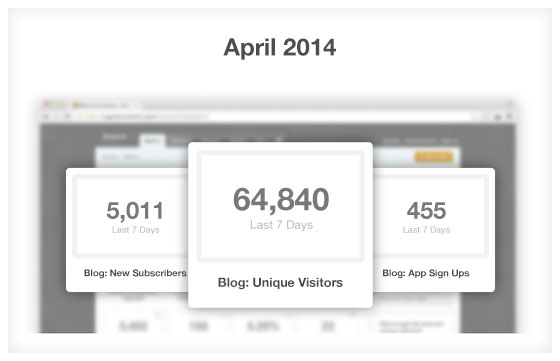
How much time do you spend writing vs. promoting your posts? Is it a 50/50 split?
Mistake #3: Making it too hard for people to sign up
If you’re not making it ridiculously easy for people to subscribe to your email list, you’re cheating yourself of loyal, long-term readers.
I knew we were doing something wrong when I got this email:
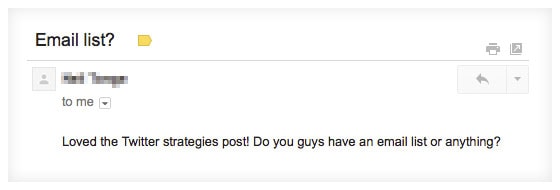
At the time, this was our pop-up email subscriber opt-in form:
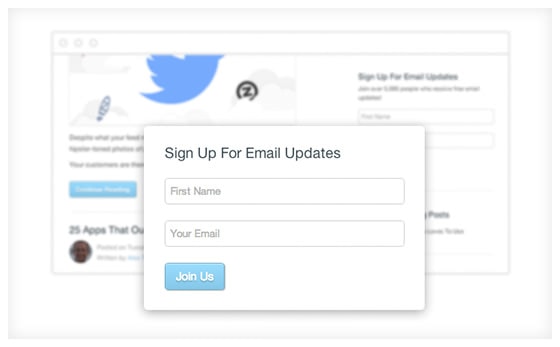
Soon after I got that email, we added a prominent sign-up form at the end of every post with a direct call to action that made it clear why the reader should sign up:
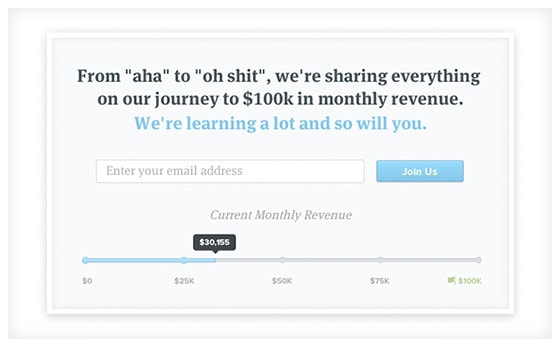
The result? The new form nearly tripled our signup rate overnight.
And we’re not the only ones.
Noah Kagan, founder of AppSumo, set out to try and capture more email subscribers to his site, OkDork.
The change that made the biggest impact on signup conversion rates?
Adding a big, unmissable signup form to his homepage:
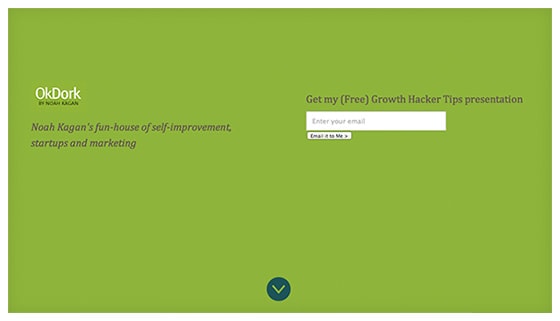
His conversation rate went from 3% to around 5%, nearly doubling with one simple change.
You may already have email subscriber opt-in forms in place, but they may not be as easy to find as you think.
Test different CTAs in different locations – simple changes can lead to dramatic conversion lifts.
Mistake #4: Letting people forget about you
Are your readers hearing from you regularly?
If not, there’s a good chance they’re forgetting about you.
Here’s why that’s bad:
A year ago, when posting once every two-to-three weeks, our open rates were low (averaging around 15%) and our unsubscribe rate was higher (around 3%) than it should’ve been.
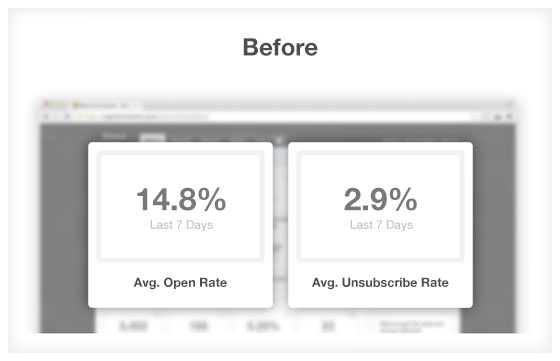
When we started posting and emailing weekly, both stats improved significantly; open rates more than tripled to nearly 50%, and unsubscribes are down to under 1%.
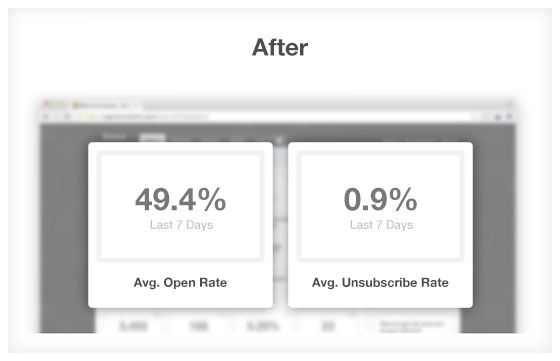
Becoming a regular presence in your readers’ lives keeps them engaged and eager to read your content. Being erratic and disappearing from their inboxes for weeks at a time makes your email just another annoyance they didn’t expect.
How often should you post?
Unfortunately, there’s no single best answer here.
Derek Halpern says a few times a month is fine. Neil Patel, on the other hand, writes eight blog posts a week (I’m exhausted just typing that).
The only way to know what works for your unique audience is to – you guessed it – test for yourself.
But whichever rhythm you find works best for you, make sure your readers get used to hearing from you regularly and consistently.
They’ll learn to expect your emails and posts and you’ll get the benefit of having a loyal, engaged audience.
How to apply this to your blog
Just like anything else in marketing, blogging is a learned skill.
Even successful bloggers make mistakes. You’re going to screw up, and not every post is going to be a hit.
The important thing is learn, move on, and do better next time.
It takes effort, practice and a whole lot of mistakes to get things right and start turning your blog into a serious driver of new customers.
Do a gut check right now – are you making any of these common blogging mistakes? Correct them now and avoid a painful part of the learning process.
![]()
